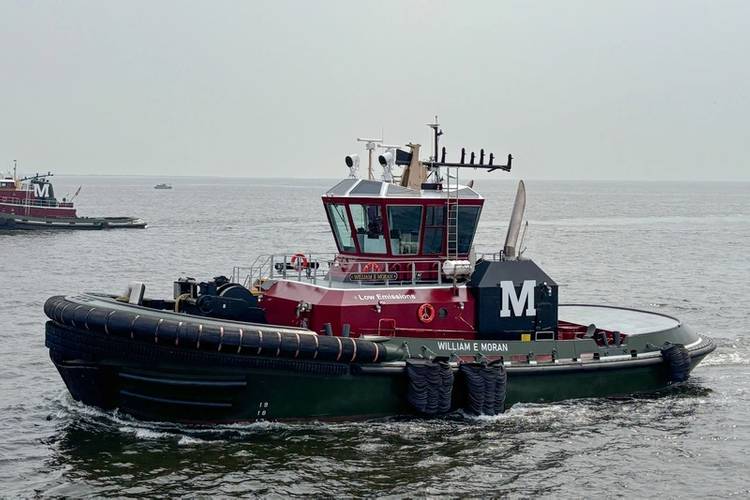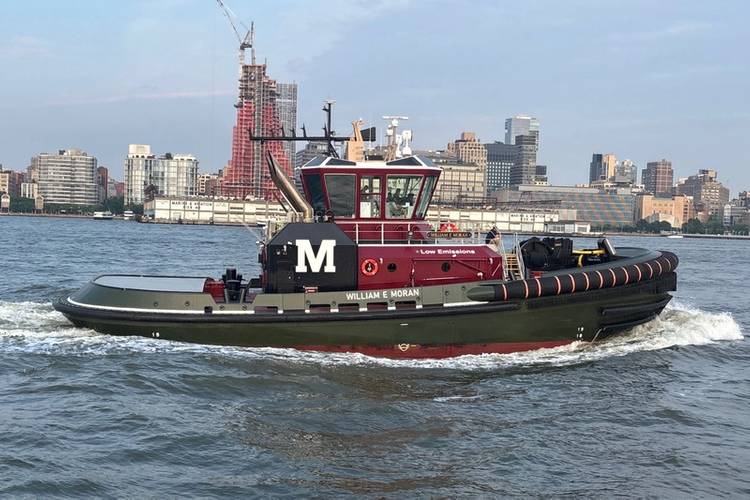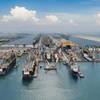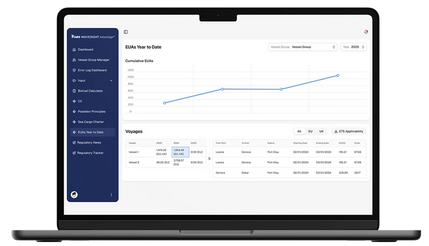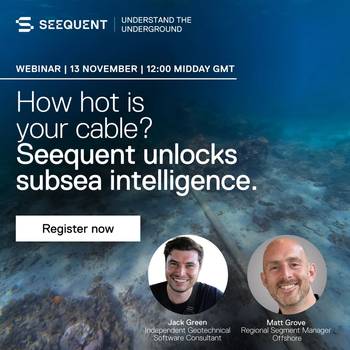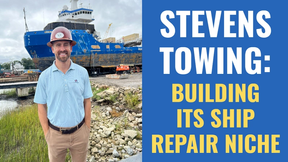Marine News Boat of the Year: William E Moran, First in Class
The William E. Moran has entered service in New York, bringing enhanced capability and performance to Moran’s evolving fleet. As the first vessel in the company’s next-generation class, it is purpose-built to meet the demands of modern port operations, support evolving customer needs, and advance Moran’s goals for safety, efficiency, and environmental responsibility. These next-generation tugs will be among the largest in the fleet, underscoring Moran’s continued focus on delivering safe, reliable, and innovative maritime solutions.
Built by Master Boat Builders in Coden, Alabama, and designed by Robert Allan Ltd., the William E. Moran belongs to the RApport 2800 series. This modern ASD tractor tug is engineered for high-performance escort and ship-assist operations. Measuring 92 feet in length with a 40-foot beam, the vessel delivers more than 80 metric tons of bollard pull, equipped to manage the increasing size and complexity of vessels calling at U.S. ports with precision and control.
“These tugs represent a leap forward in our ongoing commitment to providing best-in-class maritime solutions,” said Sean Perreault, COO, Maritime Services, Moran. “Through our collaboration with Master Boat Builders and Robert Allan Ltd., we have leveraged our design expertise to create vessels that deliver exceptional performance and compliance while offering adaptability to meet our customers’ evolving demands.”
The William E. Moran is ABS class, Escort-rated and powered by Tier IV Caterpillar 3516E engines, producing a combined 6,770 horsepower. It is LEV (Low Emission Vessel) certified, significantly reducing NOx emissions and supporting Moran’s long-term sustainability goals. The tug features twin Z-drive propulsion units for enhanced maneuverability and operational precision.
Crew safety and well-being were central to the vessel’s design. The William E. Moran includes expanded accommodations, improved working spaces, and modern onboard systems. The vessel features a fully integrated Rose Point ECS for precision navigation and Starlink satellite connectivity to ensure uninterrupted communications and data access across all operating conditions.
The arrival of the William E. Moran is part of Moran’s broader fleet-renewal strategy. Additional vessels in this class are under construction and expected to deliver later this year.
165 Years of Evolution
Founded in 1860, Moran has grown from a single-service tug operator into one of the most diversified marine enterprises in North America. “We started off in the ship-assist business, so ship docking was our bread and butter for many years,” Perreault said. “More recently, we’ve expanded into a couple of other business lines. Today we’re made up of two divisions – the Maritime Division and Specialty Services – and within those we have four business units covering ship assist, transportation, environmental and industrial services, and dive and construction.”
Between the two divisions, Moran employs nearly 2,000 people, operating 80 ship-assist tugs in 17 ports and maintaining a fleet of 14 ocean-going barges. “Over the last 18 months, we’ve delivered seven new tugs into the operating fleet,” Perreault said. “The William E. is one of those – and a real milestone in our continuous-build program.”
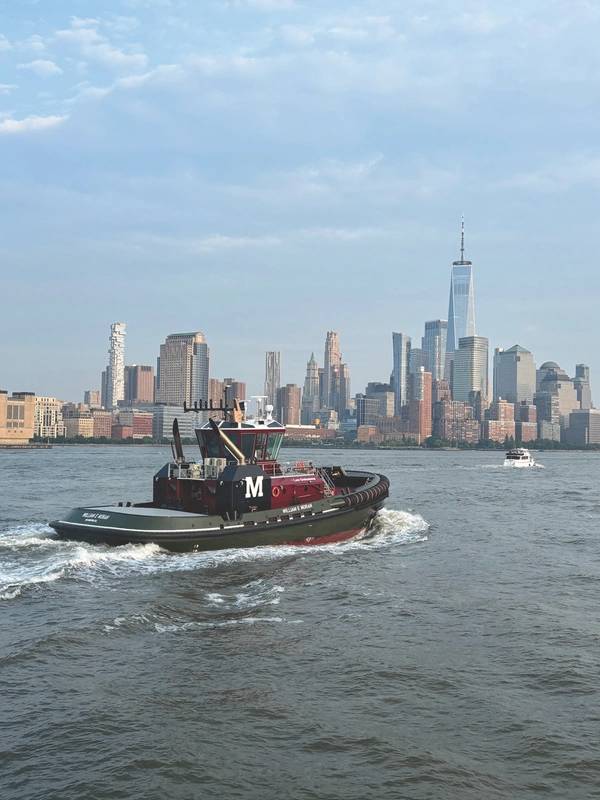 Photo credit: Jess Yeomans
Photo credit: Jess Yeomans
Power, Flexibility, Familiarity
The William E. Moran embodies Moran’s effort to create a standardized yet flexible tug platform that can be deployed across multiple ports and missions. “We were looking for a platform that allowed us to meet all of our needs throughout the ship-assist business unit,” Perreault explained. “Each of our 17 locations has slightly different requirements. We wanted a tug that was handy enough to handle general ship-assist work anywhere but also capable of being outfitted for high-performance terminal service – firefighting, larger winches, and high-speed escort work.”
This led to a focus on commonality and crew familiarity. “As people move from one boat to the next, they should have that sense of familiarity,” he said. “Standardization helps with safety, training, and efficiency, but it also gives us a core design that any qualified U.S. yard can build for Moran for years to come.”
Visibility was another key focus during design collaboration with Robert Allan Ltd. “Operator visibility is huge,” said Perreault. “These tugs have full-height windows all the way around, 360 degrees, deck-to-overhead. We even raised the pilot house slightly and moved it aft, which gives much better sightlines to the foredeck and alongside when close to ships. It’s exponentially better visibility than we’ve had before.”
Inside and out, the William E. Moran reflects Moran’s emphasis on operator comfort, maintainability, and data-driven reliability. “We spent considerable time on the layout – how we outfit the interior, arrange equipment, and ensure connectivity for those aboard,” Perreault said. “We want to take care of the folks that take care of us. They’re living away from home, and we want these vessels to feel as much like home as possible.”
The tug integrates real-time equipment monitoring systems designed in-house by Moran engineers. “We’ve incorporated a variety of systems to collect data continuously,” Perreault said. “We can access that data shoreside to troubleshoot issues, and, more importantly, identify problems before they happen.
By comparing performance across the fleet, we can spot trends early and maintain that high level of availability that our customers expect.”
For Moran, the William E. Moran class is also a response to increasing vessel size, evolving regulations, and higher expectations from clients and crews alike. “As ships continue to grow, tugs have to grow – more power, greater escort capability, larger winches,” Perreault noted. “Customers are looking for 80-ton boats, so that’s where we’ve positioned this class.”
Beyond horsepower, new escort stability requirements and fire-suppression regulations influenced the design. “The timing of those regulatory changes mattered,” he said. “It forced us to adapt our approach to layout and firefighting systems.” Crew feedback has been integral as well. Moran’s new-construction team maintains a direct feedback loop with crews, allowing onboard observations – from equipment placement to small habitability details – to feed directly into the next build cycle. “They’re great ideas, and we really welcome that feedback,” Perreault added.
Balancing Investment with Efficiency
While these next-generation tugs represent a significant capital investment, Moran views the returns in operational efficiency and longevity. “We continuously invest because our customers are investing,” Perreault said. “Each new class brings improvements, and yes, that often means higher CapEx, but we offset it through smarter operations. That includes better dispatching, technology that improves utilization, and more efficient workflows. The idea is to be better than the last class in every measurable way.”
Moran currently has five additional vessels under construction, scheduled for delivery between late 2025 and Q1 2027, continuing the company’s methodical renewal strategy. “I don’t see that changing over the next 12 to 24 months,” Perreault confirmed.
- William E. Moran Main Particulars
- Builder | Master Boat Builders – Coden, Alabama
- Designer | Robert Allan Ltd. (RApport 2800 series)
- Owner | Moran Towing Corporation
- Type | ASD Tractor Tug / Escort-rated
- Classification | ABS Escort-rated / LEV (Low Emission Vessel) certified
- Length o.a. | 92 ft (28 m)
- Beam | 40 ft (12.2 m)
- Bollard Pull | >80 metric tons
- Main Engines | 2 × Caterpillar 3516E EPA Tier IV diesels (6,770 bhp combined)
- Propulsion | Twin Z-drive azimuthing thrusters
- Generators | Caterpillar C7.1 auxiliary sets
- Navigation & Control | Rose Point ECS Integrated Navigation; ABS Escort Systems
- Communications | Starlink satellite connectivity; VHF/UHF bridge suite
- Fendering | Manuplas system
- Fire Protection / Suppression | Firemaster fire insulation package to latest U.S. CG standards
- Insulation | Isover CCR CR2 ALU1-50; Isover KL-32-50; Isover KL-33-70
- Accommodation / Crew | Expanded berthing for crew comfort; modern galley and mess





